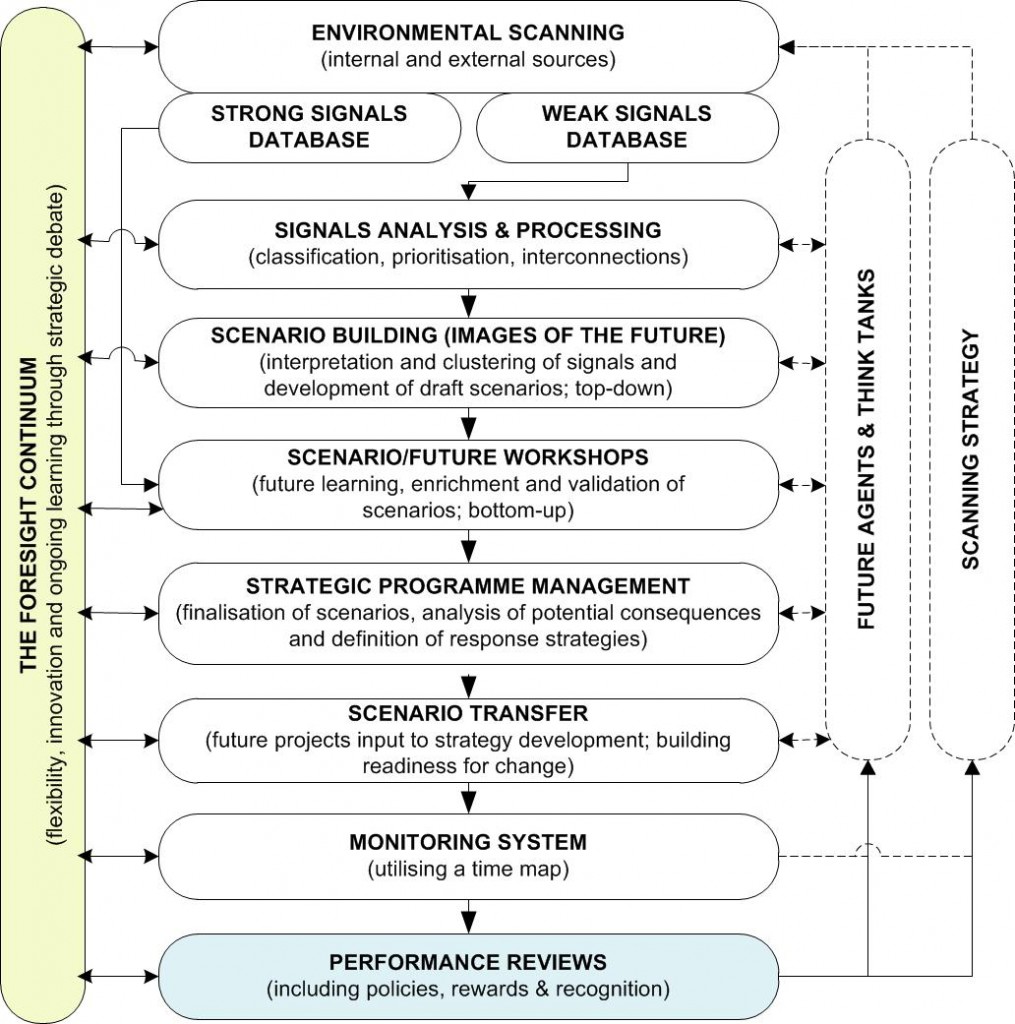Research has enriched the practice framework from case study research through the identification of the component of performance reviews. Both the literature and foresight experts confirm the role of this element in a foresight framework to ensure that policies, training and skills are present in order for an organisation to take advantage of foresight. Through this process, an organisation can enrich its learning capabilities for foresight. This performance review occurs at the end of the foresight process; it will assess the organisation’s willingness to adapt and identify the difficulties of managing strategic and cultural change, implementing strategic initiatives and formulating strategic responses based on foresight knowledge.
One of the key contributors to new practice from case study research is the acknowledgment of the foresight continuum, which enables an organisation to benefit from increased flexibility in decision-making, innovation and ongoing learning through strategic debate, initiated and enabled by a foresight framework. While the literature confirms the benefits of foresight through future planning from scenario building, to enable adaption to change and grow an organisation, it is argued that the “foresight continuum” is a more capacious term to describe the ongoing and strategic benefits.

Figure 8: Performance Reviews and Foresight Continuum (© Marc K Peter / FutureScreening.com™)
In investigating the research propositions, it became evident that there is a stronger link between foresight and innovation than initially anticipated. A foresight-centric planning process reflects more open debate and reveals more divergent scenarios for consideration. Through the open conversations, employees are more willing to present and debate ideas across all levels of the organisation, in turn re-energising strategic debate and supporting innovation. Foresight experts have argued that to be successful, innovation culture must be a part of the organisation, reflecting core corporate values. In one case organisation, innovation is part of the company culture, ensuring successful foresight and strategy development via listening to and using information in a top-down and bottom-up process. This creates a flat hierarchy and allows an organisation to be in a constant state of change and means that the organisation is conceptually and culturally prepared for change. Case study research provided evidence that foresight supports innovation, corporate thinking and strategic decision-making through the elimination of complexities and misunderstandings.
Practice Implications Derived through the Research
A toolset for advancing strategic corporate foresight can only succeed if the organisation’s culture embraces innovation, and the reverse is also true: without a foresight process and adequate methods and techniques, a company cannot foster sustainable innovation. In addition, company structure and hierarchy seems to have an influence as well. Therefore, as innovation is “uncontrolled” and “spontaneous”, both processes and tool sets should be used as guiding elements or an infrastructure, and not viewed as stiff boundaries for foresight and strategy support. In one case organisation, the whole organisation is helping to look forward, with limited centralised steering. This is different to other organisations, where employees try to “protect” their ideas. Corporate culture plays a vital role as the organisation’s culture must support innovation; the company vision and strategy must be connected with market insights and programmes need to be available to support future growth.
Foresight is a prerequisite for innovation and ongoing debates and conversations are essential, during workshops, through future agents or by way of any other channel of communication. The outcomes of these workshops will be included in the overall strategy development process and enrich the strategic analysis. Sharing of foresight knowledge with executive management allows them to feed relevant information back to the foresight team and stakeholders across the organisation. This, in turn, allows foresight conversations from both a top-down and bottom-up perspective and enables a strategic debate to happen across the whole organisation.
A downside of foresight-centric approaches to strategic planning is that decision-making can take longer because of its democratic nature. In addition, the research revealed that organisations with traditional approaches to, and tools for, strategic planning will exhibit a narrow, one dimensional view of the future and in return, will anticipate only incremental change and convergent perspectives on the future. By contrast, foresight driven organisations which utilise strategic programme management and scenario transfer, enable and prepare themselves with a culture of innovation, future oriented debates and conversations and readiness for change. It allows them to build a portfolio with divergent, strategic alternatives and initiatives and enrich, align and prepare their functional business units to consider strategy, future thinking and consequences. This readiness for the future will again allow flexible decision-making as strategies are being implemented. Although time consuming, it is evident that a dedicated, continuous foresight process is necessary in order to cover issues not necessarily catered for by traditional strategy planning processes.
